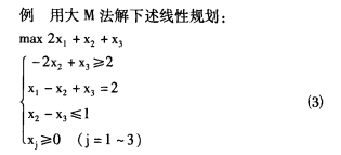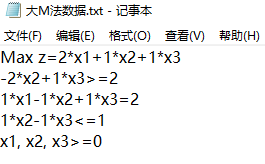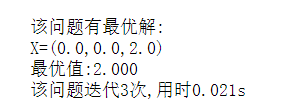【机器学习5】python实现单纯形法和大M法
目录
- 1.手算--单纯形法
- 2.Python--单纯形法
- 3.Python包--单纯形法
- 4.Excel--大M法
- 5.python--大M法
写在前面:
关于单纯形法和大M法的原理,自己去百度吧,本篇文章只是给出了算法过程~
1.手算–单纯形法
题目:
手写计算最优解为为:27500
手算全过程请留言~
2.Python–单纯形法
题目依然是上面的↑
import numpy as np
def pivot(d,bn):
l = list(d[0][:-2])
jnum = l.index(max(l)) #转入编号
m = []
for i in range(bn):
if d[i][jnum] == 0:
m.append(0.)
else:
m.append(d[i][-1]/d[i][jnum])
inum = m.index(min([x for x in m[1:] if x!=0])) #转出下标
s[inum-1] = jnum
r = d[inum][jnum]
d[inum] /= r
for i in [x for x in range(bn) if x !=inum]:
r = d[i][jnum]
d[i] -= r * d[inum]
def solve(d,bn):
flag = True
while flag:
if max(list(d[0][:-1])) <= 0: #直至所有系数小于等于0
flag = False
else:
pivot(d,bn)
def printSol(d,cn):
for i in range(cn - 1):
if i in s:
print("x"+str(i)+"=%.2f" % d[s.index(i)+1][-1])
else:
print("x"+str(i)+"=0.00")
print("objective is %.2f"%(-d[0][-1]))
d = np.loadtxt("D:\\my.txt", dtype=np.float)
(bn,cn) = d.shape
s = list(range(cn-bn,cn-1)) #基变量列表
solve(d,bn)
printSol(d,cn)
3.Python包–单纯形法
题目依然是上面的↑
#导入包
from scipy import optimize
import numpy as np
#确定c,A_ub,B_ub
c = np.array([50,100])
A_ub = np.array([[1,1],[2,1],[0,1]])
B_ub = np.array([300,400,250])
#求解
res =optimize.linprog(-c,A_ub,B_ub)
print(res)
4.Excel–大M法
题目如下:
excel得到的结果如图:最优解为2
过程和上面的单纯法差不多 ~不清楚的先去学习单纯法吧 ~
5.python–大M法
题目是第4步骤贴出来的题目,代码参考: https://blog.csdn.net/desirew/article/details/79795554
import os
import re
import numpy as np
import time
"""
输入线性规划模型到一个文档中,程序读取线性规划模型,化其为标准型。
找到初始可行基,建立单纯形表,迭代求解,判断解的类型,输出结果。
"""
#读取线性规划模型,并返回字符串列表
def inPut():
# 读取线性规划模型
model_str = []
with open("大M法数据.txt",'r') as f: #建立一个文本文档 储存线性规划模型
lines = f.readlines()
for element in lines:
element = element[:-1]
model_str.append(element)
return(model_str)
#得到价值向量c
def find_C(model_str):
x_temple = re.findall(r"-?\d+\.?\d*",model_str[-1])
x_temple = [int(i) for i in x_temple]
x_max = max(x_temple)
c_temple = re.findall(r"-?\d+\.?\d*",model_str[0])
c_temple = [float(i) for i in c_temple]
c_list_1 = c_temple[1::2]
c_list_2 = c_temple[::2]
c=[]
for i in range(x_max+1):
c.append(0)
for i in range(len(c_list_1)):
c[int(c_list_1[i])] = c_list_2[i]
c = np.array(c)
return c
#求系数矩阵+资源向量
def find_A(model_str):
b = []
x_temple = re.findall(r"-?\d+\.?\d*",model_str[-1])
x_temple = [int(i) for i in x_temple]
x_max = max(x_temple)
A = [[0 for i in range(x_max+1)] for i in range(len(model_str)-2)]
k = 0
for element in model_str[1:-1]:
x_temple = re.findall(r"-?\d+\.?\d*",element)
x_temple = [float(i) for i in x_temple]
x_list_1 = x_temple[1::2]
x_list_2 = x_temple[:-1:2]
x=[]
b.append(x_temple[-1])
for i in range(x_max+1):
x.append(0)
for i in range(len(x_list_1)):
x[int(x_list_1[i])] = x_list_2[i]
for num in range(len(x)):
A[k][num] = x[num]
k += 1
for num in range(len(b)):
A[num][0] = b[num]
A = np.array(A,dtype = np.float_)
return A
#由以上三个函数可得到 1.系数+资源向量矩阵 2.价值向量 A c b 三个变量
#为进行资源向量非负化,约束条件等式化,记录每个约束的形式( =记为0,>记为1,<记为-1)
def constraintCondition(model_str):
yueshu = []
for element in model_str[1:-1]:
if '<' in element:
yueshu.append(-1)
elif '>' in element:
yueshu.append(1)
else:
yueshu.append(0)
yueshu = np.array(yueshu)
return yueshu
#对A,b进行标准化
def change_A(str,A,c,yueshu):
#约束条件等式化
for i in range(A.shape[0]):
if A[i,0]< 0:
yueshu[i]*=-1
A[i]*=-1
for i in range(A.shape[0]):
if yueshu[i] == 1:
#添加松弛变量
temple_list = [0 for j in range(A.shape[0])]
temple_list[i] = -1
A = np.column_stack((A,temple_list))
for i in range(A.shape[0]):
if yueshu[i] == -1:
#添加剩余变量
temple_list = [0 for j in range(A.shape[0])]
temple_list[i] = 1
A = np.column_stack((A,temple_list))
elif yueshu[i] == 1:
#添加人工变量
temple_list = [0 for j in range(A.shape[0])]
temple_list[i] = 1
A = np.column_stack((A,temple_list))
elif yueshu[i] == 0:
# 添加人工变量
temple_list = [0 for j in range(A.shape[0])]
temple_list[i] = 1
A = np.column_stack((A,temple_list))
return A
#对价值向量c进行标准化
def change_c(str,A,c,yueshu):
if 'in' in str[0]:
c = c*-1
#约束条件等式化
for i in range(A.shape[0]):
if A[i,0]< 0:
yueshu[i]*=-1
for i in range(A.shape[0]):
if yueshu[i] == 1:
#添加松弛变量
c = list(c)
c.append(0)
c = np.array(c)
for i in range(A.shape[0]):
if yueshu[i] == -1:
#添加剩余变量
c = list(c)
c.append(0)
c = np.array(c)
elif yueshu[i] == 1:
#添加人工变量
c = list(c)
c.append(-pow(10,9))
c = np.array(c)
elif yueshu[i] == 0:
# 添加人工变量
c = list(c)
c.append(-pow(10,9))
c = np.array(c)
return c
#基变量对应的价值系数
def C_B(x_b,c,m):
c_b = []
for element in x_b:
c_b.append(c[element])
return c_b
#计算检验数
def CN(A,c,x_b,c_b,m,n):
cn = [0]
for num_1 in range(1,n):
cj = c[num_1]
for num_2 in range(m):
cj = cj - c_b[num_2] * A[num_2,num_1]
if 0 < cj and cj < 0.0001:
cj = 0
cn.append(cj)
return cn
#判断解的情况
def judge(A,cn,m,n,x_b,c_b):
#最优解
num = cn.count(0)
if max(cn) <= 0:
for j in range(len(c_b)):
if c_b[j] == -pow(10,9):
if A[j,0] !=0:
return 4 #无可行解
if num == m+1:
return 1 #有最优解
else:
return 2 #有无穷多最优解
else:
for num in range(len(cn)):
if cn[num] >0:
lis = []
for i in range(m):
lis.append(A[i,num])
if max(lis) < 0:
for j in range(len(c_b)):
if c_b[j] == -pow(10,9):
if A[j,0] !=0:
return 4 #无可行解
return 3 #有无界解
return 0 #继续迭代
#计算theta
def theTa(cn,A,m):
theta = []
j = cn.index(max(cn))
for num in range(m):
if A[num,j] > 0:
theta.append(A[num,0] / A[num,j])
else:
theta.append(float("inf"))
return theta
#进行基变换
def baseChange(A,cn,theta,m,n):
# 找出中心元素
j = cn.index(max(cn))
i = theta.index(min(theta))
main_elem = A[i,j]
A[i] = A[i] / main_elem
for num in range(m):
if num != i:
A[num] = A[num] - A[num][j] * A[i]
return A
#进行基的换入与换出
def X_B(cn,theta,x_b):
j = cn.index(max(cn))
i = theta.index(min(theta))
x_b[i] = j
return x_b
#计算最优值
def Value(c_b,A,m):
value = 0
for num in range(m):
value += c_b[num] * A[num,0]
return value
#打印单纯形表
def Excel(A,c_b,x_b,c,theta,cn,m,n):
print("%6s"%"Cj", end="")
print("%6s"%"Cj", end="")
print("%6s"%"Cj", end="")
for i in c:
if i != -pow(10,9):
print("%6.1f"%i,end="")
else:
print("%6s"%"-M",end="")
print("%6s"%"theta")
#第二行
print("%6s"%"CB", end="")
print("%6s"%"XB", end="")
print("%6s"%"b", end="")
print("%6s"%"b", end="")
for i in range(1,n):
print("%6d" % i,end="")
print("%6s"%"--")
#打印数字
for i in range(m):
if c_b[i] != -pow(10,9):
print("%6.1f" % c_b[i],end="")
else:
print("%6s" % "-M",end="")
print("%6d" % x_b[i], end="")
print("%6s" % "", end="")
for j in range(n):
print("%6.1f" % A[i,j] ,end="")
print("%6.1f" % theta[i])
#打印检验数
print("%6s"%"CN", end="")
print("%6s"%"CN", end="")
print("%6s"%"CN", end="")
for i in range(n):
if cn[i]>10000 or cn[i]<-10000:
print("%6s" %"MM", end="")
else:
print("%6.f" % cn[i],end="")
print("%6s" % "--")
print("")
def outPut(result,value,x_b,A,X):
if result == 1:
num = 0
for i in x_b:
if i <= len(X):
if A[num,0]<0:
print("该问题无可行解:")
return
X[i-1] = A[num,0]
num +=1
print("该问题有最优解:")
print("X=(",end = "")
for i in range(len(X)):
if i == len(X)-1:
print("%.1f"%X[i],end = "")
else:
print("%.1f,"%X[i],end = "")
print(")")
print("最优值:%.3f"%value)
elif result == 2:
print("该问题有无穷多解,其中一个最优解为:")
num = 0
for i in x_b:
if i <= len(X):
if A[num,0]<0:
return 4
X[i-1] = A[num,0]
num +=1
print("X=(",end = "")
for i in range(len(X)):
if i == len(X)-1:
print("%.0f"%X[i],end = "")
else:
print("%.0f,"%X[i],end = "")
print(")")
print("最优值:%.3f"%value)
elif result ==3:
print("该问题有无界解")
elif result ==4:
print("该问题无可行解")
#输入线性规划模型,找出变量
def solve():
str = inPut()
startTime = time.time()
yueshu = constraintCondition(str)
c = find_C(str)
A = find_A(str)
X = [ 0 for i in range(A.shape[1]-1)]
#标准化
A = change_A(str,A,c,yueshu)
c = change_c(str,A,c,yueshu)
#得到矩阵的维数
m = A.shape[0]
n = A.shape[1]
#确定初始可行基X的下标,x_b存储可行基X的下标
x_b = []
for i in range(m):
x_b.append(n-m+i)
#X_B对应的价值系数c_b
c_b = C_B(x_b,c,m)
#初始单纯形表建立
#1.计算检验数cn, theta
#2.判断解的情况 若未达到终止条件 找到主元素 改变可行基 进行单位变换 进行第一步
#3.若达到终止条件,输出结果
num = 0
while True:
cn = CN(A,c,x_b,c_b,m,n)
theta = theTa(cn,A,m)
num += 1
Excel(A,c_b,x_b,c,theta,cn,m,n)
result = judge(A,cn,m,n,x_b,c_b)
if result != 0:
break
theta = theTa(cn,A,m)
A = baseChange(A,cn,theta,m,n)
x_b = X_B(cn,theta,x_b)
c_b = C_B(x_b,c,m)
value = Value(c_b,A,m)
if "in" in str[0]:
value *= -1
outPut(result,value,x_b,A,X)
endTime = time.time()
time_1 = endTime - startTime
print("该问题迭代%d次,用时%.3fs" % (num,time_1))
solve()







